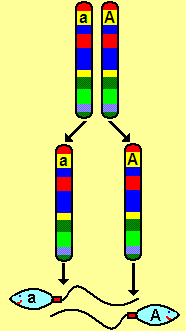Home
Genetics
Genetic
Crosses
History
Glossary
Puzzles
About
this site
Site
map
WebQuest
|
Genetic crosses
(Note: before you
start this section it is advisable that you have learned a lot of the
words associated with genetics. You may already have learned them. If
not you can study the "Genetics" pages on this website, or you can
refer to the Glossary on this site to find the meanings of any words
you don't know).
* While reading
this page, be sure to
pass the mouse cursor arrow over every picture you encounter.
This page will teach you a useful skill, predicting the
possible genotypes in a cross between parents of known genotypes.
When meiosis (special
cell division) produces gametes, homologous pairs of chromosomes are
separated, and any one sperm or egg
produced ends up with either one or
the other of the chromosomes.
This means that for any pair of alleles in the parent, the gamete is
equally likely to get one or the other allele (but not both).
-
A sperm or egg has
only
one allele of each gene.
-
A parent has two
alleles for each gene.
-
The offspring
produced by a cross also have two alleles, one from each parent.
The diagram below shows
how this happens in sperm production. (Pass the cursor arrow
over the diagram)
 |
Here are two homologous chromosomes in a "sperm mother cell".
One chromosome has a recessive allele, (a).
The other chromosome
has a dominant allele (A)
During meiosis, the homologous chromosomes are separated.
The a
goes to one
cell. The A
goes to another cell.
Half of the male's sperm cells end up with an a.
The other half of his sperm cells have an A. |
Meet
the volunteers
Before we learn how to predict the genotypes of offspring of
genetic crosses, what say we find some
volunteers to help us provide
examples.
As there are some people who object to using people as experimental
subjects, we are going to use some alien creatures whose genetic
inheritance system just happens to be very similar
to ours. They have a
number of single-gene controlled traits which each have two possible
alleles, one dominant and one recessive.
So meet the aliens. (Pass the cursor arrow
over them to see
their
greetings).



You
probably noticed that lady aliens have pink eyelids, long eye-lashes,
no elbow knobs and bigger, pink belly buttons.
Any
other differences you can see can be found in both males and females.
Don't even ask about exactly how they ... um have little
aliens. This isn't one of those
websites! I can tell you it does involve laying a sizable clutch of
eggs eggs though.
Some
genetic traits
of the
aliens are listed below.
| Trait |
Allele
symbols and phenotypes |
| Dominant
allele |
Recessive
Allele |
|
Skin colour
Antennae
length
Ear size
Snozzle length
Head knob
|
 |
G
Green skin
A
Long antennae
E
Large ears
N
Long snozzle
K
Knob present
|
g
Yellow skin
a
Short antennae
e
small ears
n
short snozzle
k
Knob absent
|
(Put the mouse cursor
arrow over the diagram
to see recessive traits)
The
steps
involved in
predicting offspring genotypes
(These
steps apply to
any genetic cross, no matter how simple or how complicated).
-
Write down the
genotypes of the parents.
-
Work out the
genotypes of the sperm and eggs.
-
Work out all of the
combinations of alleles possible in
the offspring.
-
Work out the
phenotypes of the offspring, and the
phenotype ratio if there are two (or more) phenotypes possible.
Now
for an example
Let's
cross a pure breeding green alien with a pure breeding yellow
one.
Step
1. Parent
genotypes:
GG
X
gg
Step 2. Possible gamete genotypes: all G
all g
Step 3.
Possible offspring genotypes:
Gg
Step 4. Phenotype(s)
of offspring (F1):
All green
NOTE:
The offspring of a cross
between homozygous dominant and homozygous recessive parents are called
the "first filial generation" or F1. This
term was used by Gregor Mendel, the "father of genetics". (See History
page).
Using a Punnett
square
Working out a cross between heterozygous individuals is more
complicated so we use a method invented by British geneticist, Professor Reginald
Crundall Punnett, (1875
- 1967)
The steps above are still followed but you use the diagram to help work
out the various combinations.
Example: To predict the possible offspring genotypes of a
cross between the sort of heterozygous green aliens in the F1
above we will use a Punnett square.

Step
1:
Parent genotypes:
Gg
Gg
Step 2: Gamete genotypes
G
or g
G
or g
Step 3: This is where we use the Punnett square.
- The
gamete genotypes are
placed in the boxes on the top and side of the grid.
-
There is no rule
about
which parent goes on the top or side.
- There
must be only one
letter in each of the spaces on top, and only one letter in each of the
spaces to the left.
-
You then transfer the
letter at the top of a column to each
row below it,
-
Next transfer the
letters at the side to each column beside it.
-
You should end up
with
two letters in each of the boxes of
offspring genotypes. These are the genotypes of the F2 (= second filial
generation - obtained by crossing members of an F1).
-
Step
4: Work out the phenotypes from the
genotypes.
-
Any
genotype with at least one capital G
will give a green
alien. (GG
or Gg)
- Any
homozygous genotype with two recessive alleles (gg)
will give
yellow.
- So
there are three
ways
of getting green aliens and only one way of getting a yellow alien.
That is:
3
green : 1 yellow
-
We call this a 3 :
1 ratio.
- An
F2 produced from an
original cross between parents who are homozygous dominant and
homozygous recessive will always give a 3 : 1 phenotype ratio.
The
test
cross
Why
would you use a test cross?
-
Imagine you want to
breed
aliens for sale as pets. You research the alien pet market and discover
that while everybody wants to own an alien with a long snozzle, nobody
would want to own one with a short snozzle. (In
case you are wondering, short snoz aliens are prone to feeding
difficulties and are not very healthy).
-
You go to a breeder
who
wants to sell you some long snozzled aliens. some of them may
be heterozygous (Nn) ones that could produce homozygous recessive,
short snoz offspring?
-
He tells you that all
of
his stud males are certified, pure
breeding long snoz individuals (NN). They have been test-crossed to
make sure.
What
is a test cross ? (sometimes
called a
back-cross)
-
You can not tell the
genotype of an individual which has a phenotype caused by a dominant
allele - it could be heterozygous (Nn) or homozygous dominant (NN).
-
You do
know the genotype of an individual showing the recessive phenotype. It
has to be homozygous recessive (nn) for the alleles to have an effect.
-
A
test cross involves
crossing an organism that has a phenotype due to a dominant allele with
a member of the opposite sex which is homozygous recessive for that
trait.
- If the test subject
(with the dominant phenotype) is indeed homozygous dominant, it can not
have offspring with the recessive trait.
-
If the test subject
is heterozygous, about half of its offspring will have the recessive
trait when it is crossed with a homozygous recessive individual.
Example
of a test cross ?
To test cross your long
snoz stud
male alien to ensure it is NN and not Nn you
would cross him with one or more short snoz (nn) females.


- If he is
pure breeding homozygous dominant (NN), then all of his sperm will
carry the N allele. Therefore all of the offspring will have long
snozzles.
1. Parent
genotypes:
Male NN
Female nn
2. Gamete
genotypes:
sperm N
eggs n
3. Offspring
genotypes:
all
Nn
4. Offspring
phenotypes:
all long snozzle
-
If he is not
pure breeding, but is heterozygous, (Nn) there will be a difference.
1. Parent
genotypes:
Male Nn
Female nn
2. Gamete
genotypes: sperm N
or n
eggs n
3.
Offspring
genotypes: (Pass
mouse cursor over Punnett square below)
(the
area in grey is not really needed as it is the same as the row above)
4.
Offspring phenotypes: 1
long snozzle : 1 short snozzle
- Note that this
could be
thought of as a 2:2 ratio, cancelled down to a 1:1 ratio.
Any
testcross/backcross with a heterozygous individual would always give a
1:1 ratio, so you know that your subject of the cross is not pure
breeding.
There
are a few facts you
need to remember when thinking about these
ratios.
-
Ratios are not really
probabilities.
-
Probabilities are
usually given as fractions or percentages.
-
The probability of
getting a short snozzled alien in the cross shown in
the Punnett square above is ½, or 1 out of 2, or 50%.
-
The probability of
getting a yellow alien when two green heterozygous aliens mate is
¼, 1 out of 4 or 25%.
-
Remember that these
are only probabilities. It is like tossing a coin. The chances are 1
out of two you will get heads. If you toss a coin ten times you might
expect to get 5 heads and 5 tails, but you could get any number of
heads - even ten. That is because it is still a one in two chance every
time you toss. This toss now can not affect the next toss or the toss
before. In the long run they may balance out.
-
So, if our short snoz
female aliens in the cross above produce 20 offspring, we might expect
10 short and 10 long snoz babies, but the numbers would probably be
different. However, if you got even one short snoz baby, you
would know the male is not homozygous.
Finally
You now need to try
working out a few crosses on your own.
Use the table of traits
above to get the information you need to work out the following crosses.
Remember to follow
through the four
steps for each cross, using
Punnett squares where needed.
-
Find the genotypes
and phenotypes of the F1 and F2 when pure breeding long antennae aliens
are crossed with pure breeding short antennae aliens.
-
Find
the genotypes and phenotypes
of the F1 and F2 when pure breeding large eared aliens are
crossed
with pure breeding small eared aliens.
-
Find
the genotypes and phenotypes
of the F1 and F2 when pure breeding knobbed aliens are
crossed
with pure breeding unknobbed aliens.
-
Work out a test cross
between a heterozygous knobbed male alien and a homozygous recessive
unknobbed female.
|
 A site for
learning
about basic genetics
A site for
learning
about basic genetics A site for
learning
about basic genetics
A site for
learning
about basic genetics




